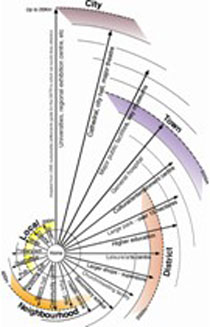
CITIES AND FUTURE*, by Richard Rogers |
 |
I am passionate about cities. They are the very drivers of our culture and of our economy. The only sustainable form of development in the modern age is the compact, well connected, well-designed, environmentally responsible, live-work-leisure city, where poor and rich can co-exist side by side and not in ghettos. Cities are first and foremost for the meeting of people – for friends and strangers, and for the exchange of goods and ideas. The concepts of citizenship, civil society and civic responsibility were all born in the city. Interesting things can happen when there is a mix of people and activities in fl exible spaces. Well-designed buildings and public spaces can encourage social inclusion and bring joy to users. If we build well, we can create a socially inclusive environment. A way of measuring the quality of life in cities is by the design of public spaces which can contribute great vitality. Every individual should have the right to well-designed public space – this should be part of a charter of human rights. Everybody should be able to sit on their own door step or a bench close to their home, and they should be able to see a tree from their window. Everyone should be able to find a public square a few minutes from their front door and be able to reach a park easily. The most important rule of successful sustainable urban development is to develop only brownfield land and underused buildings and not to expand onto greenfield sites. Rather, we should build a hypothetical ‘wall’ around the existing city or, better still, a green belt, and use this to encourage denser development around public transport hubs. Intensifi cation of existing land allows existing facilities – such as transport, schools, hospitals, government buildings, as well as roads and public transport – to be used, thereby limiting the use of cars and discouraging suburban sprawl. Information technology has given us the power to study and analyse the global power of cities. If you look at satellite pictures of the earth at night, you can see a clearly defined and farreaching network of cities in many parts of the world. Today, more than 50 % of the world’s inhabitants live in cities, whereas 100 years ago it was only 10 %. We need to ensure that modern cities are designed on a scale which is relevant to the needs of the citizens who inhabit them and which encourage people to walk around and meet in a safe environment where individuals are literally the ‘eyes and ears’ on the street. The biggest crisis we are all facing is climate change. If we do not make clear decisions about the control of carbon fuels, we could witness the destruction of mankind in the foreseeable future. Buildings and transport are responsible for around 70 % of all CO2 in the world and architecture – including city planning – can have a major impact on reducing these emissions. Depending on how we plan, we can make some big improvements. All energy ultimately comes from the sun, and we need to harness clean energy using climate-friendly technology that does not produce CO2, by using not only the sun itself but also the wind, the sea and thermal energy. We have to see the earth as a living, organic entity that we must respect – and that we are responsible for. Global warming as well as our dependence on carbon-based fuel needs to be reduced quickly and dramatically. Climate change is happening all around us. If it continues at its current rate, it will not only destroy the glaciers of the Arctic and Antarctic regions, it will also destroy mankind. We are already witnessing the effects of climate change in terms of flooding, famine and political extremism. Teamwork is the key to good urban design. A project is not the work of a single person; it is made by many talented partners, great clients, good construction teams and consultants all working together. As a practice, we are interested in the social environment and social inclusion as well as the beauty of the environment in which we live and work. As architects, we give order, scale and rhythm to space, in a celebration of beauty and function, of science and art.
* Richard Rogers + Architects: From the House to the City, Fiell Publishing, 2010


